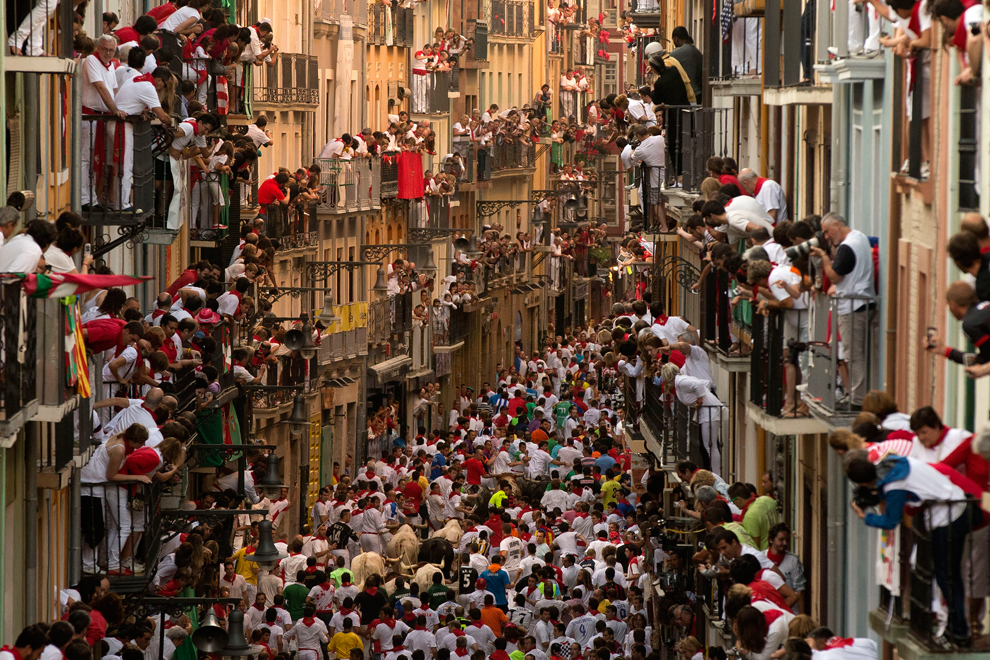
Pamplona hosts the festival of all festivals. When the chupinazo or rocket goes off on July 6th the city explodes to life. Thousands of people from across the world converge on this city which is coloured white and red for the occasion. Over the course of a few days the streets are filled with an outpouring of fraternity, joy and merrymaking accompanied by the rhythm of the charangas bands and fiestas. The running of the bulls is the only part of the day when the festival is reined in and tension flows through the air minutes before the bulls begin their journey through the streets behind the runners. The festival continues with the caldico (broth), chocolate with churros, the procession, the giants and big-headed carnival figures, sipping an aperitif, the running of the bulls and the fireworks which segue into the night-time commotion.
The origin of the fiesta of San Fermín goes back to the Middle Ages and is related to three celebrations: religious ceremonies in honour of San Fermín, which intensified from the 12th century onwards, trade fairs and bullfights, which were first documented in the 14th century. Initially, the fiesta San Fermín was held on October 10th, but in 1591 the people of Pamplona, fed up with the bad weather at that time of year, decided to transfer the fiesta to July so it would coincide with the Fair. This is how the Sanfermines were born. It initially lasted two days and had a pregón (opening speech), musicians, a tournament, theatre and bullfights. Other events were added later, such as fireworks and dances, and the fiesta lasted until July 10th.
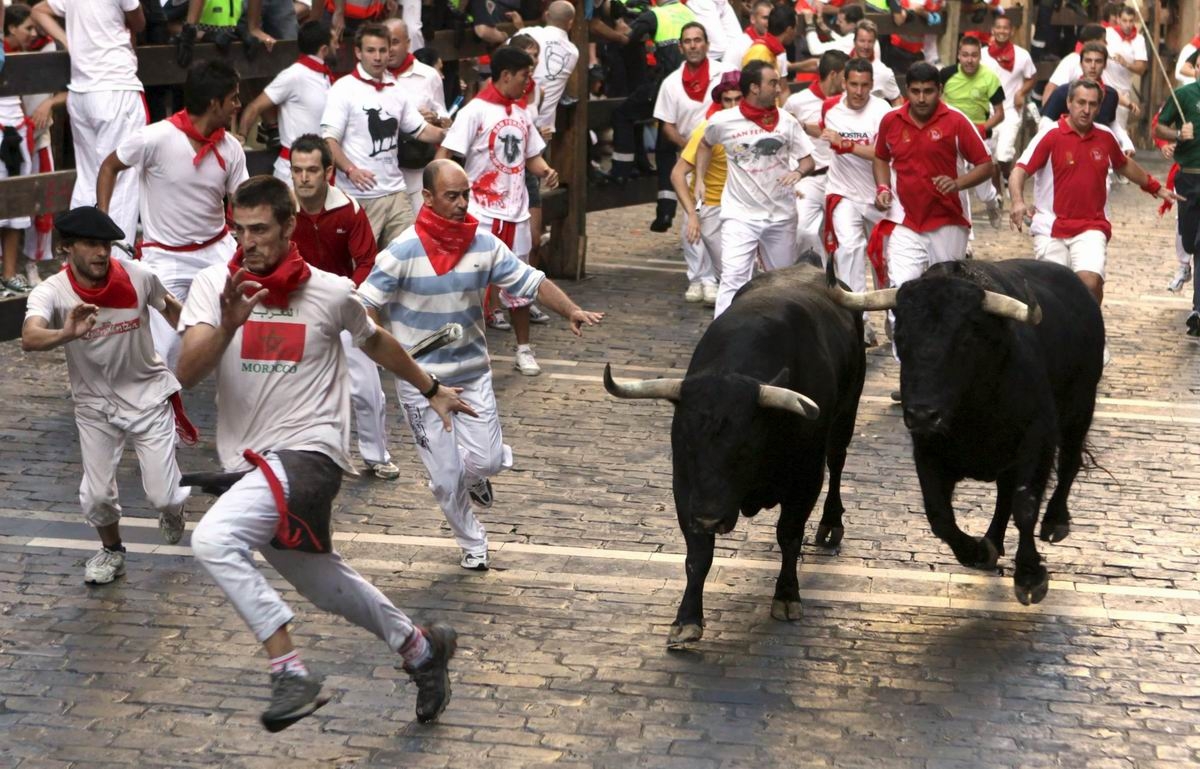
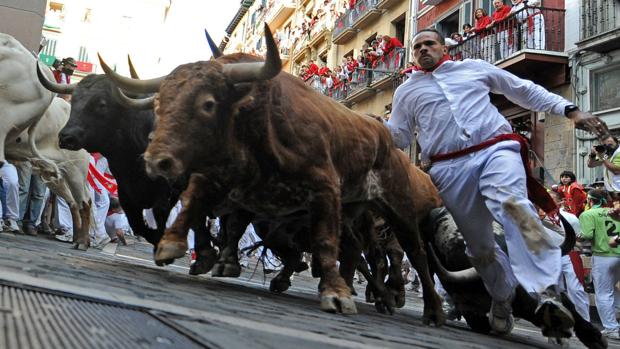
Chronicles from the 17th and 18th centuries tell us of religious events together with music, dance, giants, tournaments, acrobats, bull runs and bullfights, and the clergy's concern at the excessive drinking and dissolute behaviour of young men and women. They also refer to the presence of people from other lands, whose shows "made the city more fun". In the 19th century there were curious fairground attractions such as a woman fired from a cannon, exotic animals or wax figures, while the Comparsa de Gigantes (parade of giants) had new carnival figures with big heads, kilikis and zaldikos. Furthermore, the absence of a double fence in the bull run meant that the bulls escaped on several occasions and ran around the city streets.
The Sanfermines reached their peak of popularity in the 20th century. The novel "The Sun Also Rises" ("Fiesta"), written by Ernest Hemingway in 1926, attracted people from all over the world to come to the fiesta of Pamplona. The 20th century also witnessed new events within the fiesta such as the Riau-Riau (suspended since 1991), the Chupinazo, or the cultural programme.

The Pamplona fiestas in honour of San Fermín, the “Sanfermines”, combine official celebrations with popular festivities, religion with profanity, local with foreign, tradition with new change, order with subversion; and all in a week, from 6th to 14th July, in which the city transforms into the world capital of mirth.
They are open and hospitable festivities that welcome all - here no one is an outsider. The beat of the fiesta never ends. 24 hours of buzzing atmosphere, revelry, dances and prayers, where the city of Pamplona takes centre stage in its widest sense.
The Encierro is the event at the heart of the Sanfermines and makes the fiesta a spectacle that would be unimaginable in any other place in the world. It was born from need: getting the bulls from outside the city into the bullring.
The encierro takes place from July 7th to 14th and starts at the corral in Calle Santo Domingo when the clock on the church of San Cernin strikes eight o'clock in the morning. After the launching of two rockets, the bulls charge behind the runners for 825 metres, the distance between the corral and the bullring. The run usually lasts between three and four minutes although it has sometimes taken over ten minutes, especially if one of the bulls has been isolated from his companions.
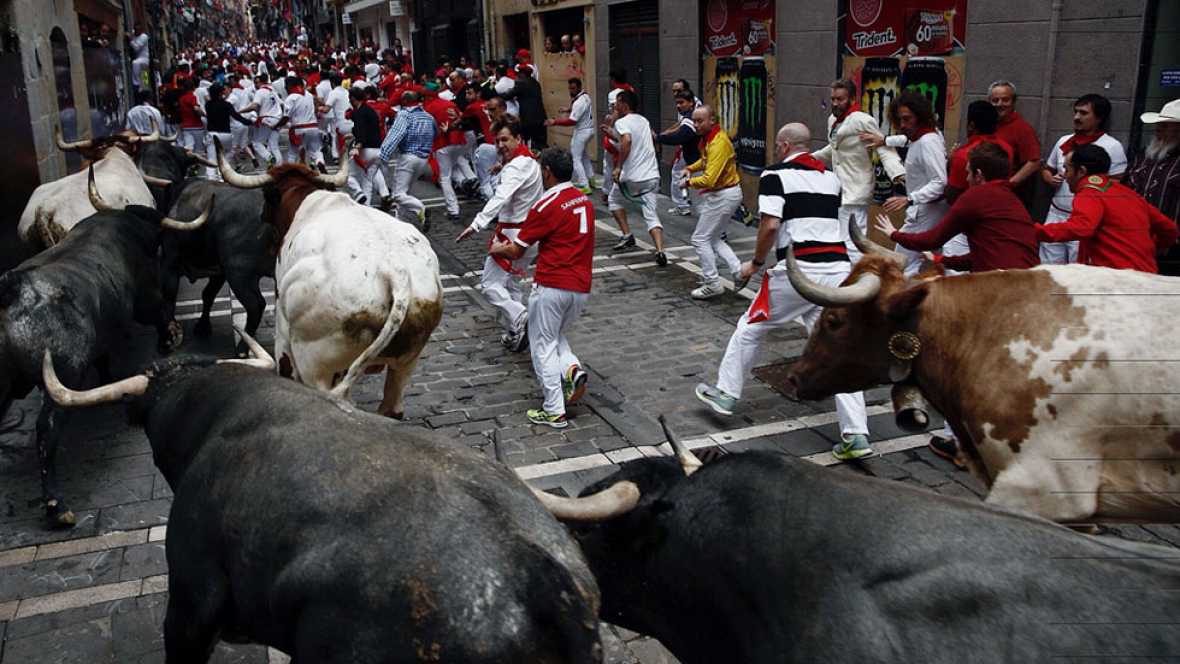
Three rockets fired from the bullring, signals that all the bulls have entered the bullring. A fourth and final rocket indicates that all the bulls are safely in the corral located inside the bullring, and that the bull run has ended.
For security reasons, a double fence marks out the route of the bull run through the streets. It is made of over 3,000 wooden parts (planks, posts, gates, etc.). Part of the fence stays put throughout the fiesta but other sections are assembled and disassembled every day by a special brigade of workers.
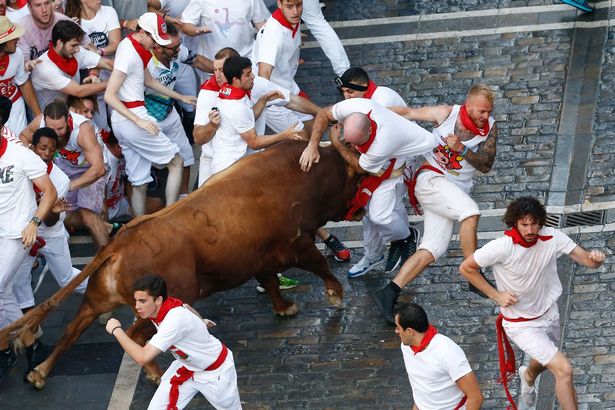
A large number of pastores (bull 'shepherds') cover the entire bull run. They place themselves behind the bulls, with their only protection being a long stick. Their main role is to stop the odd idiot from inciting the bulls from behind, to avoid the bulls turning round and running backwards, and to help any bulls that have stopped or have been separated from their companions to continue running towards the bullring.
Other key people in the bull run are the 'dobladores', people with good bullfighting knowledge (sometimes ex-bullfighters) who take up position in the bullring with capes to help the runners 'fan out' (in other words, run to the sides after they enter the bullring) and 'drag' the bulls towards the 'corral' as quickly as possible.
The encierro is an unrepeatable experience for spectators and runners alike. It is a spectacle that is defined by the level of risk and the physical ability of the runners.
An inexperienced runner should learn about the characteristics of this dangerous 'race' (although it should not be considered as a race) before starting, and also about the protective measures to be taken for his/her own safety and that of the people running alongside.
Not everyone can run the encierro. It requires cool nerves, quick reflexes and a good level of physical fitness. Anyone who does not have these three should not take part; it is a highly risky enterprise.
Runners should start somewhere between the Plaza del Ayuntamiento (City Hall Square) and the pink-slab Education building in the Cuesta of Santo Domingo, and they should be there before 7.30 a.m. because entry to the run is closed from that time on. The rest of the run, except for the stretch mentioned above, must be completely clear of runners until a few minutes before 8 a.m.
What is not allowed in the bull run:
- People under 18 years of age, who must not run or participate.
- Crossing police barriers placed to ensure that the run goes off smoothly.
- Standing in areas and places along the route that have been expressly prohibited by the municipal police force.
- Before the bulls are released, waiting in corners, blind spots, doorways or in entrances to other establishments located along the run.
- Leaving doors of shops or entrances to apartments open along the route. The responsibility for ensuring these doors are closed lies with the owners or tenants of the properties.
- Being in the bull run while drunk, under the effects of drugs or in any other improper manner.
- Carrying objects that are unsuitable for the run to take place correctly.
- Wearing inappropriate clothes or footwear for the run.
- Inciting the bulls or attracting their attention in any manner, and for whatever reason, along the route of the run or in the bullring.
- Running backwards towards the bulls or running behind them.
- Holding, harassing or maltreating the bulls and stopping them from moving or being led to the pens in the bullring.
- Stopping along the run and staying on the fence, barriers or in doorways in such a way that the run or the safety of other runners is jeopardised.
- Taking photographs inside the run, or from the fences or barriers without due authorisation.
- Carrying objects that are unsuitable for the good order and security of the bull run.
- Installing elements that invade horizontal, vertical or aerial space along the bull run, unless expressly authorised by the Mayor's Office.
- Any other action that could hamper the bull run taking place normall
If you are brave enough, get on your running shoes!